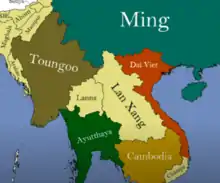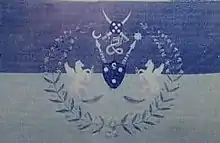Khagemba
King Khagemba,[1] formally known as Meidingu Khagemba(1597–1652),[2] was one of the most powerful monarchs that reigned in the Kingdom of Kangleipak.[3] King Khagempa consolidated and expanded his father's kingdom of Kangleipak and later successfully defended it from foreign invaders such as the Muslims,the Kachari and the Shans of the Kabaw Valley.He is also best known for his successful victory against Chinese(Khagi) invasion. His name was originally called Ningthou Hanpa After his victory against the invasion he came to be known as Khagi Ngampa and corrupted word led it to Khagemba,its a title given by the people of Kangleipak for his remarkable job as a King.[4] Muslim settlement[5] became more prominent after 1606 AD with the establishment of a Muslim Personal Law Board led by a Qazi appointed by the king.

| Khagempa | |
|---|---|
 Meetei King Khagempa's flag | |
| Successor | Khunjaoba |
| Born | Ningthou Hanba Kangla |
According to the Nongsamei Puya (a Meetei Puya),[6] Prince Sanongba[7] younger brother of Meidingu Khagemba colluded with the Muslims of East Bengal and came along with 1000 elephants, 30 horses and large number of troops to revolt against him.Meidingu Khagemba introduced bell metal currency in the kingdom of Kangleipak and a number of coins[8] from his reign have been found. His reign was considered as the golden age of Kangleipak in Kangleipak history.He was a great patron of the traditional Lainingthou Sanamahee.The book the Khagemba Langjei, [9] expresses the supremecy of Lainingthou Sanamahi as the supreme universal God.Learned scholars who were well known as Maichou at Khagempa's court were Apoimacha, Konok Thengra, Salam Sana, Yumnam Tomba, Khongngakhul Toppa,Langon Lukhoi. Khagempa was succeeded by his son Khunjaoba in 1652 who fortified Kangla and excavated a moat in the front of the brick gateway constructed by his father Khagemba. Paikhompa ascended the throne in 1666 and consolidated his power further. His kingdom extended as far as Samjok[10] to the east and Takhel to the west. In 1679 AD two Mughal,"Chaghtai Turk" princes Shah Shuja and Mirza Baisanghar led a 37 strong Mughal infiltrated and settled in Manipur by taking local wives.They later came to be known as Pangal.
References
- "JSTOR: Search Results". www.jstor.org. Retrieved 21 October 2020.
- "Did The British Have A Positive Influence On Trade In Manipur?". Youth Ki Awaaz. 6 September 2020. Retrieved 21 October 2020.
- Bhuban, Singh. "The kingdom of Manipur".
- World cat, Identities (2 November 2020). "Khagemba King of Manipur active 1597-1652". worldcat.org.
- Sanjaoli, Devi. "First Muslim Settlement in Manipur" (PDF).
- Raghu, Ningthoujam. "Science vis-a-vis Meetei Puya over Models of the Solar System: Riddle of Malem Leikoipung – KanglaOnline". Retrieved 23 October 2020.
- "The Kingdom of Manipur". e-pao.net. Retrieved 4 November 2020.
Prince Sanongba rose in rebellion. He raised a big army in Cachar, which included many Muslim soldiers with firearms, from Bengal Province of Mughal Empire
- "BRIEF HISTORY OF MANIPUR KINGDOM AND THEIR COINAGE". Retrieved 21 October 2020.
- Devi, Nunglekpam Premi (14 April 2018). A Glimpse of Manipuri Literary Works. FSP Media Publications.
- Gurumayum, Maheshwar. "Manipuri Pony: A Cavalry Horse Par Excellence - Imphal Times". www.imphaltimes.com. Retrieved 4 November 2020.